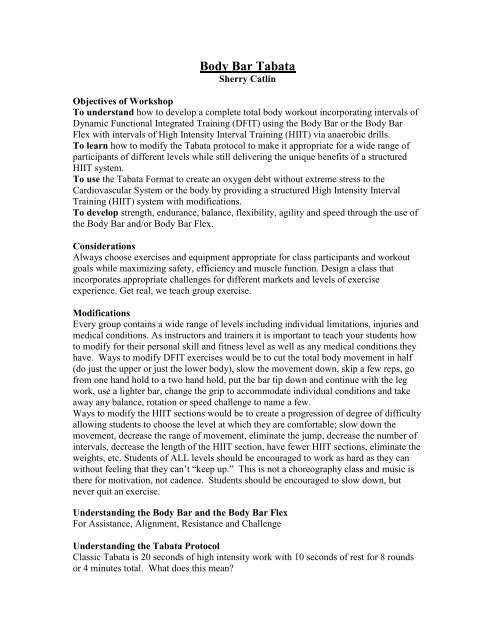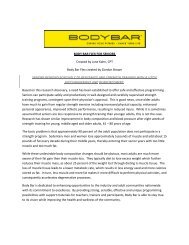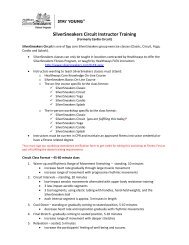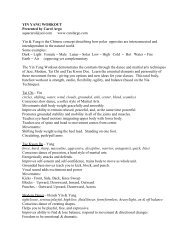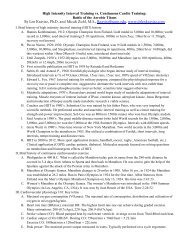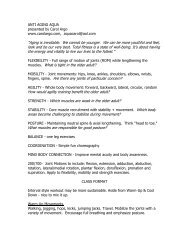Body Bar Tabata - FitnessFest
Body Bar Tabata - FitnessFest
Body Bar Tabata - FitnessFest
You also want an ePaper? Increase the reach of your titles
YUMPU automatically turns print PDFs into web optimized ePapers that Google loves.
<strong>Body</strong> <strong>Bar</strong> <strong>Tabata</strong><br />
Sherry Catlin<br />
Objectives of Workshop<br />
To understand how to develop a complete total body workout incorporating intervals of<br />
Dynamic Functional Integrated Training (DFIT) using the <strong>Body</strong> <strong>Bar</strong> or the <strong>Body</strong> <strong>Bar</strong><br />
Flex with intervals of High Intensity Interval Training (HIIT) via anaerobic drills.<br />
To learn how to modify the <strong>Tabata</strong> protocol to make it appropriate for a wide range of<br />
participants of different levels while still delivering the unique benefits of a structured<br />
HIIT system.<br />
To use the <strong>Tabata</strong> Format to create an oxygen debt without extreme stress to the<br />
Cardiovascular System or the body by providing a structured High Intensity Interval<br />
Training (HIIT) system with modifications.<br />
To develop strength, endurance, balance, flexibility, agility and speed through the use of<br />
the <strong>Body</strong> <strong>Bar</strong> and/or <strong>Body</strong> <strong>Bar</strong> Flex.<br />
Considerations<br />
Always choose exercises and equipment appropriate for class participants and workout<br />
goals while maximizing safety, efficiency and muscle function. Design a class that<br />
incorporates appropriate challenges for different markets and levels of exercise<br />
experience. Get real, we teach group exercise.<br />
Modifications<br />
Every group contains a wide range of levels including individual limitations, injuries and<br />
medical conditions. As instructors and trainers it is important to teach your students how<br />
to modify for their personal skill and fitness level as well as any medical conditions they<br />
have. Ways to modify DFIT exercises would be to cut the total body movement in half<br />
(do just the upper or just the lower body), slow the movement down, skip a few reps, go<br />
from one hand hold to a two hand hold, put the bar tip down and continue with the leg<br />
work, use a lighter bar, change the grip to accommodate individual conditions and take<br />
away any balance, rotation or speed challenge to name a few.<br />
Ways to modify the HIIT sections would be to create a progression of degree of difficulty<br />
allowing students to choose the level at which they are comfortable; slow down the<br />
movement, decrease the range of movement, eliminate the jump, decrease the number of<br />
intervals, decrease the length of the HIIT section, have fewer HIIT sections, eliminate the<br />
weights, etc. Students of ALL levels should be encouraged to work as hard as they can<br />
without feeling that they can’t “keep up.” This is not a choreography class and music is<br />
there for motivation, not cadence. Students should be encouraged to slow down, but<br />
never quit an exercise.<br />
Understanding the <strong>Body</strong> <strong>Bar</strong> and the <strong>Body</strong> <strong>Bar</strong> Flex<br />
For Assistance, Alignment, Resistance and Challenge<br />
Understanding the <strong>Tabata</strong> Protocol<br />
Classic <strong>Tabata</strong> is 20 seconds of high intensity work with 10 seconds of rest for 8 rounds<br />
or 4 minutes total. What does this mean?
The <strong>Body</strong> <strong>Bar</strong> <strong>Tabata</strong><br />
One ideal progression would be alternating HIIT <strong>Tabata</strong> sequence with a DFIT sequences<br />
to deliver a complete total body challenge in 4 minute increments for a total of 12<br />
segments adding a 5 minute warm-up and cool down.<br />
The number of <strong>Tabata</strong>s can be varied as well as the length of both the HIIT and DFIT<br />
segments. Instructors are encouraged to experiment with a template that can be used to<br />
create an endless variety of programs.<br />
Creating Intensity<br />
Range of Motion<br />
Frequency/ Duration<br />
Movement of center of mass “how far does your belly button travel”<br />
Loading –weight and plyometric variations<br />
Advanced Variations<br />
Rotation and Balance Challenges<br />
Speed and Power<br />
Reactive strength<br />
Agility and Coordination<br />
Flexibility and Mobility<br />
Level Changes with Step /Unstable surfaces with BOSU<br />
Begin with the end in mind<br />
Always use visual assessment techniques to be one step ahead of your clients needs.<br />
Once the exercise goal of the class is decided, exercise selection and sequencing is easy.<br />
There must be a method or plan to your exercise choices and sequencing. Then you can<br />
challenge your clients with meaningful variety and progressive change.<br />
Exercise Choice<br />
When choosing exercises for your program, first decide the goal or theme of the workout<br />
such as strength, endurance, power, cardio/strength interval, sports specific etc. Once<br />
you know where you want to go, you have to decide how you want to get there. First,<br />
decide on a consistent method of sequencing. Then, identify the muscle or muscle group<br />
to be targeted, the joint action, correct path and ROM, proper body position and<br />
stabilization and effectiveness of overload. Always use visual assessment of clients form<br />
to determine the risk versus the effectiveness. Proceed when technique can handle it.<br />
Exercise Progression<br />
To insure success always proceed from simple to complex, isolation to multi-joint/multimuscle;<br />
layering complexity and intensity as the body can handle it. When a strong<br />
foundation of balanced strength, endurance, flexibility and mobility are created, the<br />
student is ready to move on to incorporating balance, dynamic movement and rotation
Suggested <strong>Tabata</strong>s:<br />
Exercise (basic) Variation(s) Considerations<br />
Side Squats (alternating) Plyo<br />
Deconditioned<br />
<strong>Bar</strong> (tip down) for assistance<br />
individuals should be<br />
<strong>Bar</strong> (cradle)<br />
encouraged to not<br />
Add <strong>Bar</strong> press<br />
cradle the bar as it may<br />
fatigue their lower back<br />
Moguls (feet shoulder<br />
width)<br />
<br />
<br />
<br />
<br />
Plyo (lift feet and knees)<br />
<strong>Bar</strong> (tip down)<br />
<strong>Bar</strong> (hold bar at shoulder<br />
level parallel to front—body<br />
rotates, bar stays parallel<br />
<strong>Bar</strong> and body rotates<br />
<br />
Deconditioned<br />
individuals should be<br />
encouraged to not hold<br />
the bar at shoulder level<br />
as it may fatigue their<br />
lower back<br />
Skaters lunge <strong>Bar</strong> (held low)-<br />
<strong>Bar</strong> (alternating toss)<br />
<strong>Bar</strong> at shoulders<br />
<strong>Bar</strong> behind back<br />
<strong>Bar</strong> Tip down<br />
BB Flex anchored at hips or<br />
back<br />
Squat Jumps (or lift) <strong>Bar</strong> reverse curl and<br />
overhead press<br />
<strong>Bar</strong> shoulder press<br />
Power Squats (low) <strong>Bar</strong> (held low)<br />
<strong>Bar</strong> (alternating toss)<br />
<strong>Bar</strong> overhead press<br />
<br />
<br />
<br />
<br />
<br />
Emphasize loading outer<br />
leg and pushing out<br />
rather than swinging the<br />
inner leg to create<br />
momentum to move to<br />
side<br />
<strong>Bar</strong> held low- keep<br />
shoulder down and set<br />
<strong>Bar</strong> toss-remind to keep<br />
shoulder flexed and<br />
lifted (not into neck)<br />
Have students come to<br />
toes with full extension<br />
in the overhead press if<br />
they don’t want to jump<br />
Have students come to<br />
toes with full extension<br />
if they don’t want to<br />
jump<br />
Mountain Climbers<br />
Burpees<br />
<br />
<br />
<br />
<br />
Simple mountain climber<br />
4 count push up with 4 count<br />
mountain climber<br />
Add rotation in mountain<br />
climber<br />
Two burpees plus high knees<br />
run<br />
<br />
<br />
<br />
Pay attention to poor<br />
spinal alignment<br />
Students can omit pushups<br />
Can be performed<br />
leaning 45 degrees into<br />
a wall<br />
High Knees <strong>Bar</strong> waist height for target<br />
Add Flex <strong>Bar</strong> behind, wide<br />
grip<br />
<strong>Body</strong> <strong>Bar</strong> at Chest<br />
<br />
Using Flex <strong>Bar</strong> will help<br />
stabilize the students’<br />
core
Exercise (basic) Variation(s) Considerations<br />
Shuffles--Shoot Jump fwd and set<br />
Dunk<br />
Fast Feet add rotation and jump<br />
add jumps<br />
add <strong>Bar</strong><br />
Sprinter Drill 1 Triple and Hold<br />
Flex <strong>Bar</strong> behind<br />
Travel side for more intensity<br />
<br />
<br />
<br />
<br />
Eye socket, back pocket<br />
arms, lean forward<br />
3 Points of Flexion<br />
o Hip<br />
o Knee<br />
o Ankle/ Foot<br />
Sprinter Drill 2 w/ Jump or<br />
lift<br />
<br />
<br />
Triple push on 4 to overhead<br />
reach and lift<br />
Tuck instead of lift<br />
<br />
<br />
<br />
Eye socket, back pocket<br />
arms, lean forward<br />
3 Points of Flexion<br />
Very intense, allow<br />
students to lift to toes<br />
rather than jump if tired<br />
Sprinter Drill 3- quick step Can be boring, so an active<br />
rest might be in order (e.g.<br />
skate or heel dig)<br />
Shuffle w/ glute squat Two count shuffle pressing<br />
back into glutes and then<br />
pressing back out to shuffle<br />
opposite<br />
<br />
<br />
<br />
Eye socket, back pocket<br />
arms, lean forward<br />
3 Points of Flexion<br />
Lift hands overhead in<br />
center to prevent<br />
slouching<br />
Fencers Lunges w/ <strong>Bar</strong> Two hands on bar, thrust<br />
forward with bar at chest<br />
height. Shuffle back<br />
quickstep<br />
Shuffle Rotate x3 w/ bar Shuffle swing bar (vertical)<br />
<br />
<br />
Emphasize explosive<br />
push from rear foot<br />
COMPLETE rotation<br />
Feet change 180<br />
degrees on EACH swing<br />
Swing is from CORE, not<br />
shoulders<br />
Power jacks <strong>Bar</strong> for assistance<br />
BB OH<br />
BB Flex for stability<br />
<br />
Side touch as<br />
modification<br />
Sherry Catlin 1241 Adams Street #603 Boston, MA 02124 phone 617-298-2333<br />
sherrycatlin@gmail.com<br />
<strong>Body</strong> <strong>Bar</strong> Systems
1942 Broadway suite 314 Boulder, CO 80302 phone 800-500-2030<br />
www.bodybar.com


